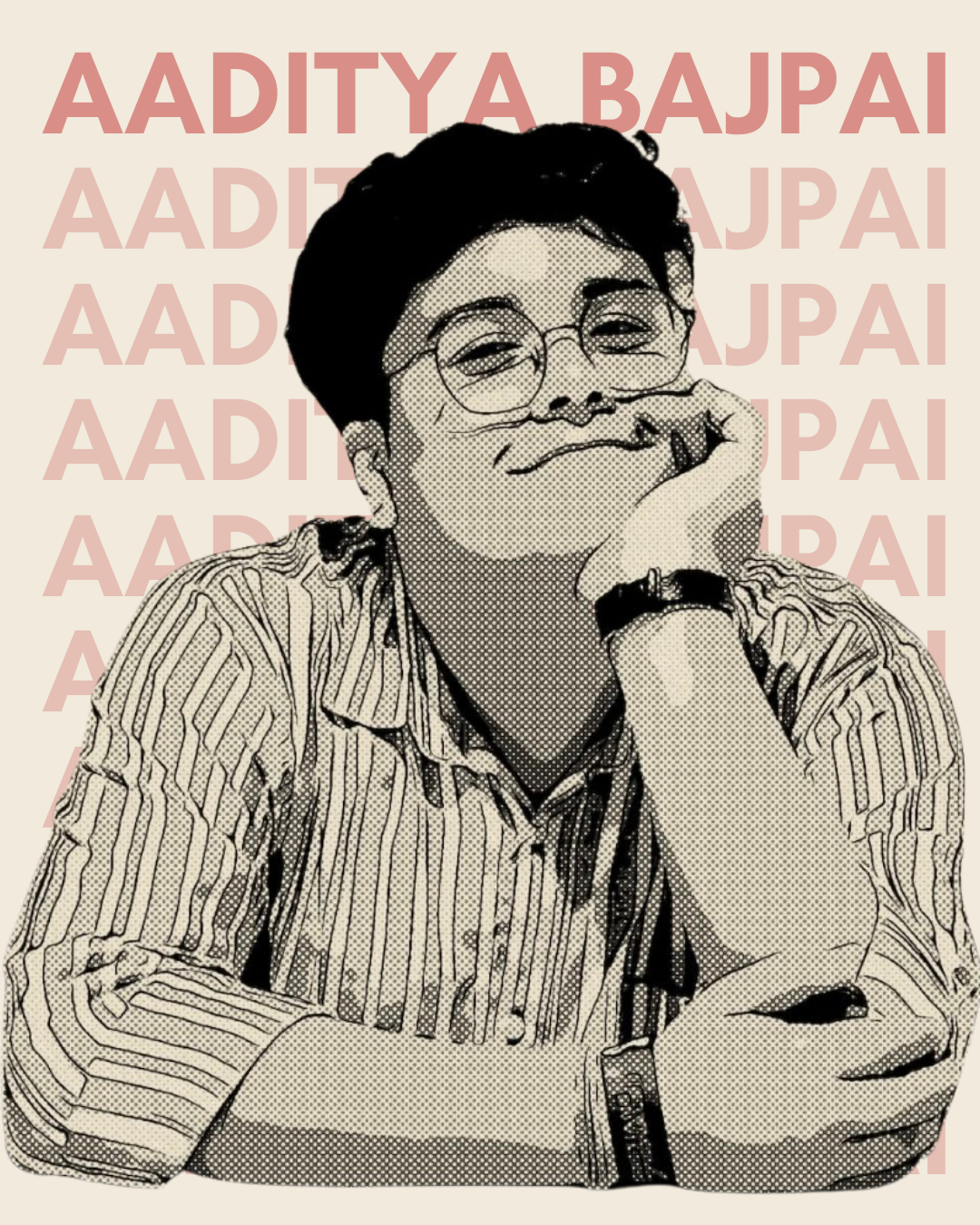The Library Wasn’t Quiet, and the Courtroom Wasn’t Loud
Meet Aaditya Bajpai, whose love for poetry has led him into the realm of intellectual property law. Through his lens, he narrates how law becomes a language that safeguards the essence of creativity. Read the full article here.

A Reflection on Law School, Art, and the Invisible Ink of Ownership
Published on July 15, 2025 . 5 min read
About the Author
Aaditya Bajpai is an LLM candidate (2025–26) in Intellectual Property Law at the University of Edinburgh, Scotland. He completed his undergraduate studies at National Law University, Nagpur, from 2020 to 2025. A published author and poet, his work explores themes of love, memory, and identity. His latest poetry collection, Letters to Her, was released in December 2024 and is available on all major e-commerce platforms. In addition to writing, he also creates music, which can be found on all major music streaming platforms.
Preface
When people talk about classic Literature, one name that always pops up is that of Fyodor Dostoevsky, the man who penned down the darkest masterpieces in the history of Russian literature. I have always claimed Shakespeare to be my inspiration behind writing prose and poetry, but truth be told, it was Dostoevsky who gave shield to my inspiration. Dostoevsky once stood in front of a firing squad at 28, minutes away from death, until a last-minute command changed everything. Where Shakespeare taught me how to speak, Dostoevsky taught me what I must protect when I do. His words did not seek applause. They sought shelter. They dared to be misunderstood, but never to be misused.
Creating art today is not just an act of sheer inspiration or romanticising leaves from a tree and expecting people to applaud. This is the age of screens & downloads, screenshots & remixes. People today just won’t applaud, rather they would try to take away what’s yours, because it matches their definition of aesthetic. This is when I found IPR, a piece of statute striving to protect an artist’s blood; a quiet contract between creation and credit. I think, there is something romantic about art being preserved by law. I never imagined bureaucracy and beauty to dine together at the same table, but they do. This is a story about how I evolved to write not just to express, but to protect it as well. This is a story about how law school helped me not to build walls, but to understand what protects them. This is a story of how I learnt what to do when a poem is plagiarized, when a melody is stolen, when a canvas is rebranded and sold under a false name.
The Duality of Silence
There is a spot on the top of the college library, not the one where you would hear people mumbling, but the one with a small bench that has learnt not to ask too many questions. Many a times, between lectures or late in the evening, I would sit there and write poems (which I never read in front of anyone). You see this is how law school gave me two contradictory forms of silence, one in that spot, and another inside the classroom. The former led to the creation, and the latter aced protection.
I remember one particular day, a Friday, I think, in February. I had just left a lecture on copyright infringement, where our professor showed us case after case of stolen ideas. Songs. Brand names. Even smells. The classroom was freezing, my mind flickering, and someone in the back yawned loudly. But I sat still, unable to breathe. Because halfway through a dull slide about infringement damages, I realized, this is not paranoia. This is prophecy. The world doesn’t just consume art now. It extracts it. It mines it. It files it in legal folders, rebrands it, profits from it, and leaves the original artist begging not for applause, but for recognition.
Poetry met Precedent
I was thinking differently now. The pressure? Heightened. I began writing legal metaphors, love as contract, memory as copyright, or maybe heartbreak as fair use? I always aimed to keep law and literature separate. But eventually it came to me that law wasn’t polluting my poems, it was rearming it. Because what is law if not the art of language wielded with terrifying precision? And what is poetry if not the law of language broken beautifully?
No one actually ever knew, not even my parents, about the dual life that I was living. By day, I was taking notes, learning sections and citing case law; by night, I was writing sonnets and satires about ceiling, litigations, and sunflowers. One of them, a stern woman with a love for torts, once told me, “There’s no place for emotions in law.” I nodded respectfully. Then I went home and wrote a five-stanza ode to the concept of injuria sine damno.
Dead Poets in the Courtroom
There is a scene in Dead Poets Society, you know the one, where Prof. Keating tells his students, “We don't read and write poetry because it's cute. We read and write poetry because we are members of the human race. And the human race is filled with passion. And medicine, law, business, engineering, these are noble pursuits and necessary to sustain life. But poetry, beauty, romance, love, these are what we stay alive for.” I watched that film in my third year (obviously a re-watch), fatigued from a law conference that had snapped the last ounce of sincerity from my bones. I sighed that evening, not because I was depressed, but rather because I was perplexed. What is the solution to the battle between the unconscious and the law? Is it possible for you to simultaneously serve as the poet and the protector?
At times, I entertained the notion of serving as the spokesperson for artists who had been neglected for an extended period of time, advocating for their rights in unassuming courts. Not in pompous High Court buildings with pillars and robes, but in modest defences and gentle conversations: ‘He wrote that line first. It was his suffering. His cadence.’ Perhaps this is the reason I selected IPR, because if I was unable to prevent the world from snatching beauty, perhaps I could at least compose the cease and desist letter. However, the law continues to function as both a shield and a scalpel. Yes, it has the potential to safeguard an idea. However, this is contingent upon it being documented, signed, dated, and archived. What of the oral traditions? The performance that is not spoken? The mural in a village that no one has ever captured on camera? Is it because they lack a certificate that they are less authentic? Legal substantiation is mandatory. Arts needs faith. And I was constantly asked to walk the tightrope between the two.
Credits Unwritten
I always wanted to pursue Literature, but couldn’t. It doesn’t make you money. There were always moments, fleeting, fragile, when I hated it. Hated how law school forced me to intellectualize everything. A song wasn’t just it, but a probable lawsuit. A painting, maybe a copyrightable asset. However, during those periods of discontent, I often discovered myself retreating to comforting locations, such as the rooftop of the academic building, the far end of the library lawn, and beneath the amphitheatre, where the wind murmured stories from the city. The curriculum did not include those spaces. They were not evaluated. But they were where I actually learned.
The most significant lesson I acquired was that my art was not naive. It was not frivolous or immature. It was a strategic move. It was survival. And the law didn’t kill it. It made it more dangerous. So, no, my law school did not fail me. But it did not complete me either. It merely placed me at the intersection of two ancient instincts, i.e., the need to create and the need to claim. Each trademark course served as a reminder that mere originality is insufficient; one must demonstrate it. Every module on patents implied that innovation is nothing more than a fragile fantasy in the absence of protection.
Conclusion, or the Lack of One?
While preparing for moot courts, we often rehearse our opening and closing statements in the mirror or in front of someone. I once began with, “Your Lordship! This case is not just about an art, rather, it is about legacy”. I was criticised for being too dramatic. But I will be honest. I still remember that line, better than anything else I argued. Now, as I stand between the bookshelves and the suitcase, I'm mastering to be both the whisper and the watermark. The poetry and the policy. Wounded and warrior.
And maybe, just maybe, that is enough. Isn’t it?
For what is law school, if not a stage? What is courtroom, if not a theatre? And what is the duty of a lawyer who once filled pages with ink in the shadows, if not to advocate for those who were unaware they needed to be protected?
To quote Ma’am Ella Wheeler Wilcox’s words in her piece titled ‘Solitude’, “Laugh, and the world laughs with you; Weep, and you weep alone; For the sad old earth must borrow its mirth, But has trouble enough of its own.” She reminds us that joy is shared, but pain is solitary. The story is the same with art, celebrated when pleasing, but mistreated when it needs protection. And that is why, IPR matters, for it guides the artist in the silence that follows the applause. I don’t know where this ends. I just know that somewhere, between a contract and a couplet, I found myself. And maybe, just maybe, that’s where the real authorship begins.
